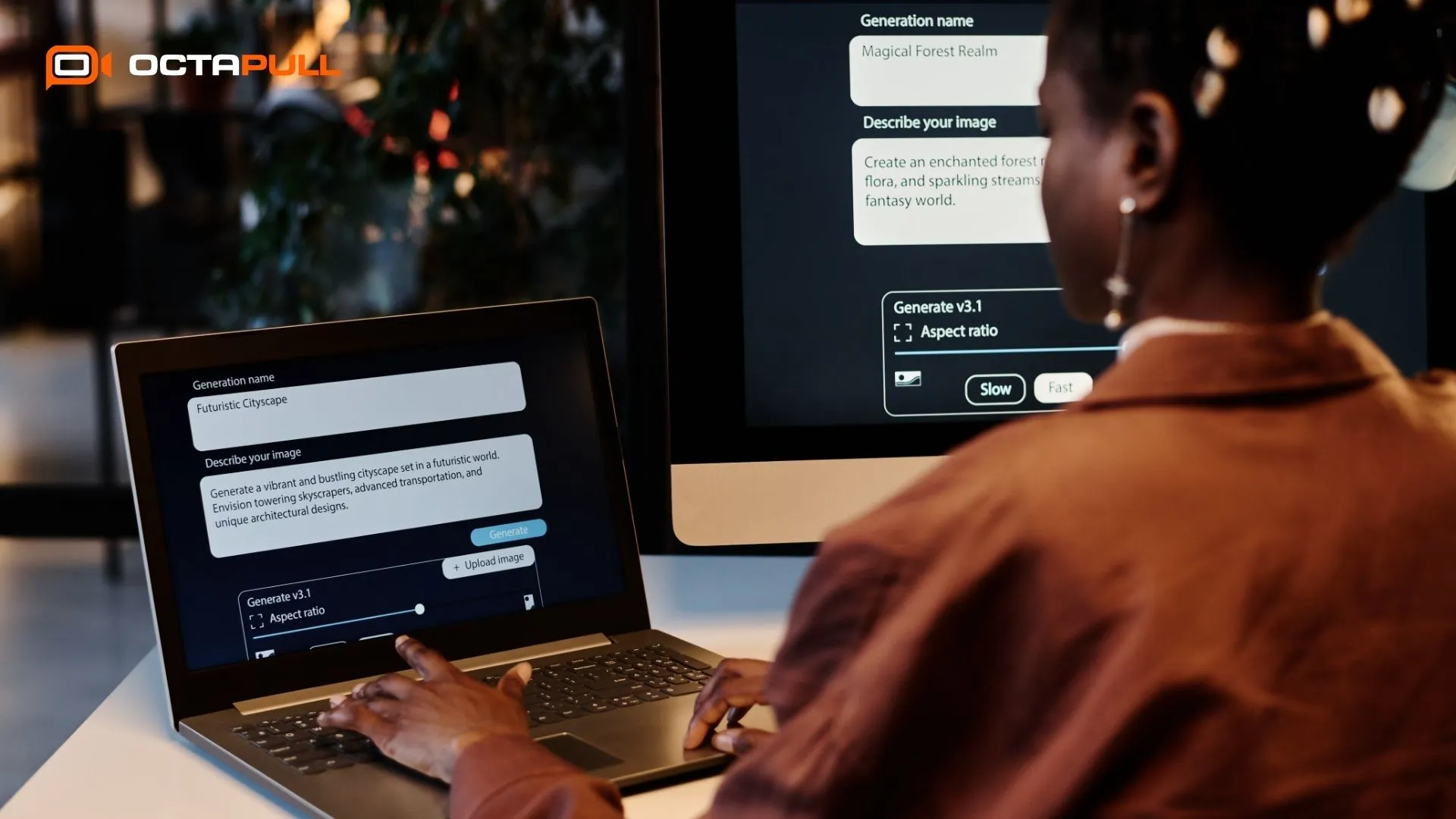Artificial intelligence (AI) has rapidly emerged as a driving force in modern business operations — from automating workflows to anticipating customer needs. One of the most transformative areas it’s redefining is the way we search for and access information.
For years, traditional search engines have relied on keywords and fixed algorithms to deliver results.
But in today’s fast-paced digital landscape, businesses demand more than a simple list of links — they seek context, insight, and conversation. That’s where AI-powered search comes in.
SearchGPT marks a significant leap forward in this evolution. Developed by OpenAI, it combines real-time web browsing with the conversational intelligence of GPT, empowering users to find, interpret, and act on information faster and more intelligently than ever before.
What Is SearchGPT?
SearchGPT is an AI-powered search assistant developed by OpenAI, combining the strengths of conversational intelligence with real-time web search.
Rather than simply returning a list of links, SearchGPT delivers clear, concise, and context-aware answers — almost like chatting with an expert who already understands what you’re looking for.
At its core, SearchGPT is built to understand natural language, interpreting the intent behind your query instead of merely matching keywords. The result is a more human, intuitive search experience.
What truly sets SearchGPT apart from traditional search engines is its ability to analyze, reason, and summarize information from multiple sources in real time.
While a conventional search might leave you scrolling through pages of results, SearchGPT reads and synthesizes that information for you — saving time and enhancing decision-making.
By integrating up-to-date web data with GPT’s advanced language capabilities, SearchGPT bridges the gap between static information retrieval and dynamic, intelligent discovery. It’s no longer just about finding information — it’s about truly understanding it.
How Does SearchGPT Work?
SearchGPT is more than just a search engine; it’s an AI-powered assistant that merges the intelligence of GPT with real-time web data.
Its ability to understand, analyze, and generate meaningful responses is transforming how businesses and individuals discover and interact with information. Let’s take a closer look at its core capabilities and how they redefine the search experience:
1. Natural Language Understanding
One of the biggest limitations of traditional search engines is their reliance on keywords. If you don’t phrase your query exactly right, you may get irrelevant results. SearchGPT overcomes this by interpreting natural language. It can understand context, nuances, and even implied intent.
For example, if you ask, “What are the latest trends in e-commerce marketing for small businesses?”
SearchGPT doesn’t just look for the words “e-commerce” or “trends,” it understands you want recent insights that are actionable for small business owners. This makes searches much more efficient and tailored to the user’s needs.
2. Real-Time Web Browsing
Unlike static AI models trained on pre-existing data, SearchGPT can access the web in real time. This means it can pull fresh, reliable information from credible sources, keeping answers current and relevant.
For businesses, this is a game-changer. Marketing teams can get the latest statistics, competitors’ updates, or regulatory changes without manually scouring multiple websites.
Researchers can quickly access newly published studies. And entrepreneurs can stay informed on emerging market trends instantly.
3. Answer Generation and Summarization
After collecting relevant data, SearchGPT synthesizes information into a coherent and readable response. Instead of simply listing links or documents, it summarizes key points, provides explanations, and presents the information in a conversational tone.
For instance, if a manager asks, “Which AI tools can improve customer support efficiency?”, SearchGPT might generate a response that:
- Lists the top AI tools with pros and cons
- Explains how each tool works in practical terms
- Suggests which tools might suit a company’s size or industry
- Provides links to credible sources for further reading
This level of contextual summarization reduces the time spent combing through multiple articles and allows businesses to make faster, informed decisions.
4. Personalization and Learning
SearchGPT also learns from interactions over time, adapting its responses to better match user preferences. For example, if a user frequently asks for concise bullet-point answers rather than long paragraphs, the AI will adjust accordingly.
For businesses, this personalization means SearchGPT can:
- Align its outputs with industry-specific terminology
- Tailor insights to company goals or user roles
- Improve efficiency in repetitive research tasks by remembering previous queries and preferences
5. Multi-Step Reasoning and Contextual Awareness
Another key strength of SearchGPT is its ability to handle complex, multi-step queries. It can combine information from different sources, reason logically, and produce a cohesive answer.
For example, a query like “What marketing strategy should a small e-commerce brand use in Q4, considering recent social media trends and competitor actions?” requires:
- Understanding the business context (small e-commerce brand)
- Identifying recent trends in social media marketing
- Analyzing competitors’ strategies
- Combining these insights into actionable recommendations
Traditional search engines would return separate articles for each part, leaving it up to the user to piece everything together. SearchGPT does this automatically, saving time and reducing cognitive load.
Key Features of SearchGPT 
SearchGPT is more than an advanced search tool; it’s an AI-powered assistant that redefines how businesses access, analyze, and act on information.
By combining natural language understanding, real-time web access, and AI-driven reasoning, it delivers capabilities that go far beyond traditional search engines.
Here’s a closer look at its key features:
1. Conversational Query Refinement
One of SearchGPT’s most powerful features is its ability to refine queries through conversation. Unlike traditional search engines that require exact phrasing, SearchGPT can interpret follow-up questions and dynamically adjust responses.
How it works:
- Users can start with a general question, then clarify or drill down for more specific information.
- The AI retains context from previous queries, maintaining a smooth, conversational flow.
Example:
- User: “Top AI tools for small businesses”
- Follow-up: “Which of these are suitable for marketing automation?”
- Result: SearchGPT refines the list and highlights marketing automation tools, saving hours of manual filtering.
Business Impact:
- Teams can explore insights interactively without restarting searches.
- Reduces miscommunication and ensures information aligns precisely with specific needs.
2. Contextual Search Results
SearchGPT doesn’t rely solely on keywords; it analyzes the meaning behind queries. This contextual awareness allows it to return results that are more relevant and actionable.
How it works:
- Understands the intent of the user beyond literal words.
- Detects nuances like industry relevance, business size, or region-specific trends.
Example:
- Query: “Marketing strategies for Q4”
- SearchGPT considers factors such as seasonal trends, current market dynamics, and competitors’ tactics to produce tailored insights.
Business Impact:
- Marketing teams can plan campaigns with precision.
- Decision-makers get insights that are aligned with real-world business scenarios, not generic information.
3. Summarized Insights Instead of Raw Links
SearchGPT goes beyond keywords by analyzing the meaning behind queries. This contextual awareness allows it to deliver results that are not just relevant, but actionable.
How it works:
- Understands user intent beyond literal words.
- Detects nuances such as industry relevance, business size, or region-specific trends.
Example:
- Query: “Marketing strategies for Q4”
- Result: SearchGPT considers factors like seasonal trends, current market dynamics, and competitors’ tactics to provide tailored insights.
Business Impact:
- Marketing teams can plan campaigns with precision.
- Decision-makers receive insights aligned with real-world business scenarios, not generic information.
4. Source Transparency and Credibility
One of the biggest challenges with AI-generated content is trust. SearchGPT tackles this by providing citations and reference links, allowing users to verify the information they receive.
How it works:
- Summaries include URLs or references to sources.
- The AI distinguishes between information drawn from primary data and content based on analysis or interpretation.
Business Impact:
- Teams can confidently leverage AI insights in presentations, reports, and strategic planning.
- Reduces the risk of spreading inaccurate or outdated information.
5. Multi-Step Reasoning for Complex Queries
SearchGPT excels at analyzing multi-faceted questions that require reasoning across multiple sources or data points.
How it works:
- Breaks down complex questions into smaller, manageable parts.
- Synthesizes insights to produce a cohesive, actionable response.
Example:
- Query: “Which marketing channels should a new e-commerce brand focus on this year, based on competitor analysis and current trends?”
- Output: SearchGPT examines competitors’ activities, identifies trending channels, ranks them by effectiveness, and provides practical recommendations.
Business Impact:
- Reduces cognitive load on employees who would otherwise compile information manually.
- Enables faster, smarter decision-making for high-stakes business scenarios.
6. Integration with Tools, Plugins, and Workflows
SearchGPT integrates seamlessly with existing business tools and software, enhancing productivity and streamlining operations.
How it works:
- Connects with CRMs, project management platforms, e-commerce dashboards, and more.
- Pulls and analyzes data from integrated tools to deliver AI-powered insights in context.
Example:
- Sales teams can query client information directly from a CRM via SearchGPT.
- Marketing teams can generate content ideas based on the latest social media trends automatically.
Business Impact:
- Turns SearchGPT into a centralized intelligence hub.
- Bridges gaps between research, decision-making, and operational execution.
7. Continuous Learning and Personalization
Over time, SearchGPT adapts to individual or team preferences, learning from past interactions to deliver more relevant and tailored results.
How it works:
- Tracks user interactions (without compromising privacy) to refine outputs.
- Learns preferred response formats, tone, and depth of detail.
Business Impact:
- Creates a personalized AI assistant for every team or department.
- Enhances productivity by delivering consistently useful, context-aware insights.
How AI-Powered Search Transforms Businesses 
AI-powered search, such as SearchGPT, is not just a technological upgrade; it’s a strategic tool that reshapes how businesses operate, make decisions, and interact with customers.
By combining real-time data with conversational intelligence, organizations can work faster, smarter, and more efficiently. Here’s how it impacts key business areas:
1. Enhanced Customer Support
AI-powered search enables companies to provide instant, accurate, and consistent responses to customer inquiries. Traditional support often relies on static FAQs or human agents, which can be slow and prone to errors.
How it works:
- Chatbots or AI agents powered by SearchGPT access up-to-date knowledge bases and external resources in real time.
- They deliver clear, context-aware answers, even for complex questions.
Example:
- A customer asks a retail website’s chatbot, “Which laptops are best for video editing under $1,500?”
- The AI retrieves the latest product specifications, compares features, and provides recommendations with purchase links — all in seconds.
Business Benefit:
- Reduces response times and improves customer satisfaction.
- Frees human agents to focus on more complex, high-value interactions.
2. Smarter Market Research
Market research can be time-consuming, requiring teams to manually analyze trends, competitor activity, and industry reports. AI-powered search streamlines this process, synthesizing vast amounts of data quickly.
How it works:
- SearchGPT scans multiple online sources, extracts key insights, and summarizes trends in digestible formats.
- It benchmarks competitors’ strategies and highlights opportunities or risks.
Example:
- A marketing team preparing a campaign for a new beverage product asks SearchGPT, “Current social media trends for beverage brands in 2025.”
- The AI generates a summary of trending campaigns, influencer strategies, and consumer behavior patterns.
Business Benefit:
- Speeds up research cycles.
- Provides actionable insights that help businesses stay ahead of competitors.
3. Improved Employee Productivity
Employees often spend a significant portion of their day searching for information internally or externally. AI-powered search reduces this research time, allowing teams to focus on high-value tasks.
How it works:
- SearchGPT accesses internal documents, databases, and external sources simultaneously.
- Employees can ask complex questions and receive curated, relevant responses in minutes instead of hours.
Example:
- A project manager asks, “What were our top-performing campaigns last quarter and what made them successful?”
- The AI analyzes internal reports and generates a clear summary highlighting key performance metrics and insights.
Business Benefit:
- Accelerates workflows.
- Reduces repetitive, manual research tasks.
- Enhances collaboration across teams with shared insights.
4. Personalized User Experiences
AI-powered search allows businesses to deliver tailored content and recommendations, creating a more engaging user experience.
How it works:
- SearchGPT analyzes user behavior, query history, and preferences to provide hyper-relevant information or product suggestions.
- Websites can offer dynamic FAQs, tutorials, or content recommendations based on individual user intent.
Example:
- An e-commerce platform uses AI search to recommend products based on browsing history and queries.
- A user searching for “ergonomic office chairs under $300” receives a curated list with detailed specs, reviews, and buying advice.
Business Benefit:
- Improves customer satisfaction and engagement.
- Increases conversion rates and loyalty by delivering personalized experiences.
5. Data-Driven Decision-Making
One of the most impactful benefits of AI-powered search is its ability to turn raw data into actionable insights, allowing businesses to make informed decisions quickly.
How it works:
- SearchGPT pulls from internal reports, external market research, and real-time web data.
- It provides summarized insights, trend analysis, and strategic recommendations.
Example:
- A retail chain asks, “Which product categories should we prioritize for the holiday season based on consumer trends and competitor pricing?”
- The AI generates a detailed report highlighting high-demand categories, competitive pricing insights, and suggested promotional strategies.
Business Benefit:
- Speeds up strategic planning.
- Reduces reliance on intuition and guesswork.
- Supports innovation by providing actionable insights for new products, campaigns, or services.
SearchGPT vs. Traditional Search Engines
While traditional search engines like Google or Bing have been indispensable for decades, AI-powered search tools like SearchGPT are redefining what it means to find and use information.
Unlike standard search engines that rely primarily on keywords and static algorithms, SearchGPT delivers context-aware, conversational, and actionable results.
Here’s a detailed comparison of traditional search and SearchGPT:
| Feature | Traditional Search | SearchGPT |
|---|---|---|
| Output | List of links requiring users to browse and synthesize information manually. | Direct, conversational answers that summarize and explain information in context. |
| Context | Keyword-based, with limited understanding of intent or nuance. | Intent-based, understanding natural language, context, and even implied meaning. |
| Updates | Periodic indexing of web pages. May return outdated information. | Real-time data access, providing the latest information from credible sources. |
| Interaction | One-way: user searches → clicks on links → finds information. | Two-way conversational interface: users can ask follow-ups, refine queries, and interact naturally. |
| Personalization | Limited; search results are mostly generic and algorithm-driven. | Deep contextual understanding, adapting to user preferences, past queries, and specific business needs. |
Conclusion
SearchGPT marks a major leap in how businesses access and leverage information. By combining AI-powered reasoning, real-time web browsing, and conversational intelligence, it transforms search from a simple, keyword-driven task into a dynamic, context-aware experience.
From enhancing customer support and streamlining market research to boosting employee productivity and enabling data-driven decision-making, SearchGPT empowers businesses to work smarter, faster, and more strategically.
As AI continues to advance, tools like SearchGPT are not just improving search; they are reshaping the way organizations operate, innovate, and engage with their audiences.


